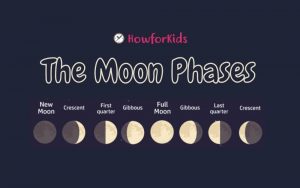
At night, the darkness of the sky allows us to see the stars and the moon. What is the moon? The moon is our only natural satellite. What is a satellite? It is a moving body that orbits around a planet.
What is the Moon?
Table of Contents
If you look at the sky at night you will see the largest cellestial body: The Moon. It looks almost as big as the Sun. The moon does not have its own light, but it reflects sunlight. During the day it can also be seen. The Moon takes almost 28 days to go around the Earth; about one month, although a month has 30 or 31 days, so that one year will have 12 exact months.
Why do the Planets stay in Orbit?
Satellites and planets rotate in an orbit due to the force of gravity. The celestial bodies in the Universe have mass and emit gravity. Gravity makes them attract to each other. The force of gravity exerted by the Sun attracts the planets, preventing them from drifting into outer space. In the same way, the Moon is attracted by the Earth’s gravity.
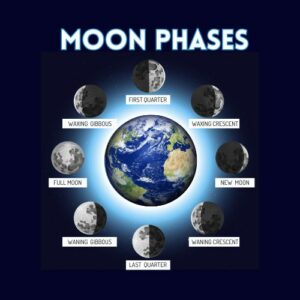
Characteristics of the Moon
- Location: The Moon is 385,000 kilometers (239,000 miles) away from planet Earth.
- Size of the Moon: The moon is about a quarter the size of the Earth. In other words, it is 4 times smaller than the Earth and it is made up of different parts:
Internal Structure of the Moon
- Crust. It is the surface, where the lunar craters can be seen. The surface of the Moon has many features, including mountains and valleys, craters, and seas (known as maria) (wide flat areas that look like seas from a distance) but are probably solidified molten rock.
Names of the lunar maria (moon seas):
- Serpent Sea (Mare Angius)
- Southern Sea (Mare Australe)
- Sea of Crises (Mare Crisium)
- Sea that has become known (Mare Cognitum)
- Sea of Fecundity (Mare Fecunditatis)
- Sea of Serenity (Mare Serenitatis)
- Sea of Cold (Mare Frigoris)
2. Mantle. It is under the crust of the moon.
3. Lunar core. In the center is the core that has two parts: an iron-rich solid inner core and a fluid outer core primarily of liquid iron. This structure is believed to have developed through the fractional crystallization of a global magma ocean shortly after the Moon’s formation 4.5 billion years ago.
Also read: The Solar System easy for Kids
Motions of the Moon
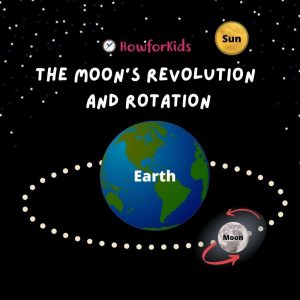
The Moon is not “still” in the sky, but rather orbits with similar movements as those of the Earth. The moon has two main movements: its revolution and its rotation. The Moon moves around the Earth in a movement called revolution. This is very similar to Earth’s revolution around the Sun. The path the Moon takes to go all the way around the Earth is called its orbit.
- Rotation Movement: The moon rotates on its axis.
- Revolution Movement: The moon moves around the earth.
The 8 Phases of the Moon explained for Kids
The apparent motion of the moon goes from east to west when seen from our planet. As the moon revolves around the Earth, both the Moon and the Earth revolve around the Sun. The Sun illuminates’ different parts of the lunar surface. It gives us the feeling, when we look from the ground, that its shape is changing. The Moon changes its appearance and we see it differently according to the time of the month. These changes are called the phases of the Moon (or lunar phases). The lunar phases are the various ways in which the face of the moon is illuminated by the Sun.
Read also: The Universe for kids
Moon Phases Information

1. New Moon 🌑
It is called the New Moon when the Moon is located between the Sun and the Earth. In this phase the moon is very dark and is not visible to the inhabitants of the Earth. We cannot see it because the illuminated part is facing back at the Sun.
2. Waxing Crescent 🌒
This phase of the moon begins two to three days after the New Moon, when a small part of the moon begins to be seen in the dark sky. It receives the name of the crescent moon because the illuminated portion of the Moon is increasing with the passing of the days. It is shaped like a small horn or fingernail. In the northern hemisphere, the right side of the Moon appears illuminated, while in the southern hemisphere the left side appears illuminated.
3. First Quarter 🌓
In the waxing quarter phase, as the Moon moves away from the Sun, we can begin to see its illuminated half from the Earth. As the days go by, this part seems to start to “grow”. From noon to midnight, only half of the right side is illuminated in the northern hemisphere and the left side in the southern hemisphere.
4. Waxing Gibbous 🌔
This is the fourth phase of the moon. It begins on the tenth day after the New Moon and lasts until the thirteenth day. It is gradually taking, day after day, a convex shape on both sides in its luminous part.
5. Full Moon 🌕
The full moon appears fourteen days after the New Moon. You can identify it because the night sky is glowing and if you look up, you will find a large pearl that reflects the light of the Sun over the Earth. One of its faces can be seen forming a perfect circle. The full moon marks the middle of the lunar month.
6. Waning Gibbous 🌖
It begins on the third day after the Full Moon until the seventh day after. The luminous part of the Moon begins to diminish with the passing of the days, thus taking again (like Moon No. 4) an appearance of a concave Moon, this time in its decreasing phase.
7. Last Quarter 🌗
The moon is approaching the Sun, and they form a right angle. This phase begins on the seventh day after the Full Moon and lasts until the tenth day.
8. Waning Crescent 🌘
This is the last phase of the lunar cycle. It extends from the 10th day after the Full Moon to the night before the New Moon. The visible face of the moon shows a thin horn that looks just like the Waxing crescent (the first phase of the moon), but on the opposite side.
Eclipses of the Moon and Sun
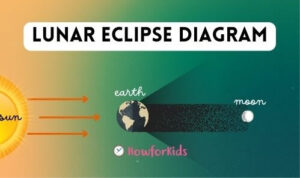
What is an Eclipse?
When the Earth, the moon and the sun are aligned, eclipses happen. When we say that one body “eclipses” another, it means that it hides it.
It is important not to confuse a solar eclipse with a lunar eclipse.
Solar Eclipse
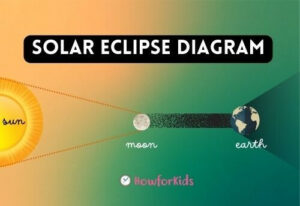
It is presented when the Moon hides the Sun, that is, the Sun remains “hidden” behind the moon; for a few minutes and in broad daylight somewhere on Earth becomes dark. The Moon “covers” the Sun, interposing itself between the Earth and the Sun. This phenomenon only occurs in a new moon, since a waning moon or a waxing moon could never cover the sun.
Lunar Eclipse
It occurs when the Earth comes exactly between the Sun and the Moon so none of the Sun’s rays can reach the Moon. In this case, both the Earth, the Sun and the Moon are aligned. The Moon is in shadows so it cannot be seen. The lunar eclipse can also be total or partial. This can only happen with a full moon. It is repeated twice every year.
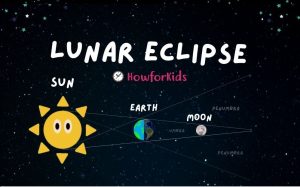
Phases of the Moon Facts for Kids
Origin of the Moon
Scientists have many different ideas about where the Moon came from and how it formed. The most current popular theory says that approximately 4 billion years ago an object the size of a planet collided with Earth. This powerful impact caused parts of the Earth to detach, which later joined together to form the Moon.
The Moon Landing
In 1969, during the North American Apollo XI mission, for the first time in human history, man reached the Moon. The first human beings to set foot on the Moon were Neil Armstrong and Elwin Aldrin. Among the experiments they carried out, they collected lunar sediments to study them.
What is the Color of the Moon?
Although from the earth we see it as yellowish white, during eclipses it is seen in red and other times we see it dark, the real color of the Moon is gray.🌑
Read Also: Solar System For Kids
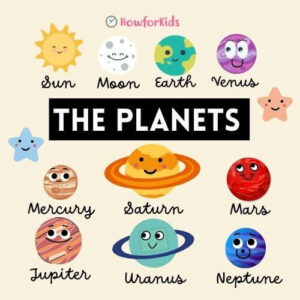
Fun Facts about the Moon
• Human beings first reached the Moon in July 1969.
• We always see the same side of the Moon. This is due to the synchronization between the movement of the Moon on its own axis (rotation) and the movement around the Earth (translation).
• There is no wind on the Moon. The dust on its surface can remain intact for centuries. In addition, the lack of air prevents breathing without oxygen masks and special suits.
• The Moon and Earth formed around the same time. The Moon does not contain water and has a very thin atmosphere.
• Temperatures on the lunar surface can vary greatly. The Moon does not have a system that prevents the Sun from getting too hot during the day and heat from escaping at night. At its warmest point on the sunny side, temperatures can reach 130 ° C. On the dark side, colder there are temperatures as low as -150 ° C.
• The Moon has surface gravity, but it is much less than that of the Earth. It is only 1/6 the gravity of the Earth. On the moon, bodies feel much lighter. What is surface gravity It is a force that attracts the objects around it. It does not need to be in contact with objects nor does it depend on the weight of objects. Surface gravity of the Moon: On the Moon, people weigh less because the force of gravity is less. As we move away from Earth, the force of gravity decreases and objects weigh less.
• The Moon also suffers from surface gravity since it is attracted to the Earth. That is why it always rotates at the same speed. If gravity did not exist, the Moon would move away from the Earth and disappear from view. The gravity of this satellite is much less than that of planet earth.
• The surface of the Moon has a large number of light and dark areas: the lunar craters. They are holes, with different depths in a circular shape. They have been produced due to the collision of meteors and asteroids against its surface. These areas were formed millions of years ago, likely by asteroid impacts which formed these craters.
• The Moon does not produce its own light. We can only see it when it is illuminated by the Sun.
• The Moon moves away from the earth 3.8 centimeters (1.1 inches) a year. This makes the days get longer and longer because our planet begins to spin more slowly around its axis. Scientists, after trips to the Moon, can measure the exact distance between the Moon and Earth. In very old days, when the Moon was much closer to Earth, the days lasted 5 hours. As the days have gone by, they have lengthened, until they reach the 24 hours they have today.
The moon has 8 phases, the moon turns red black an yellowish but its actual color is grey